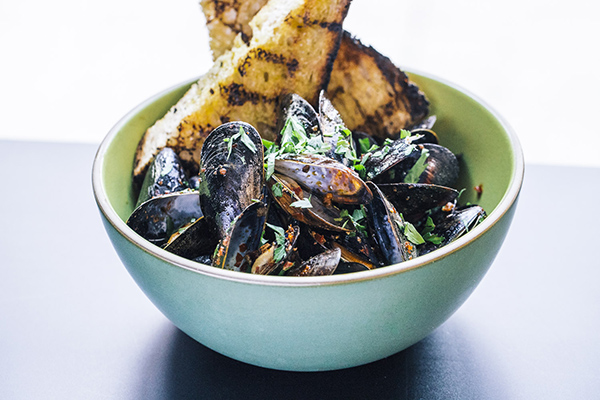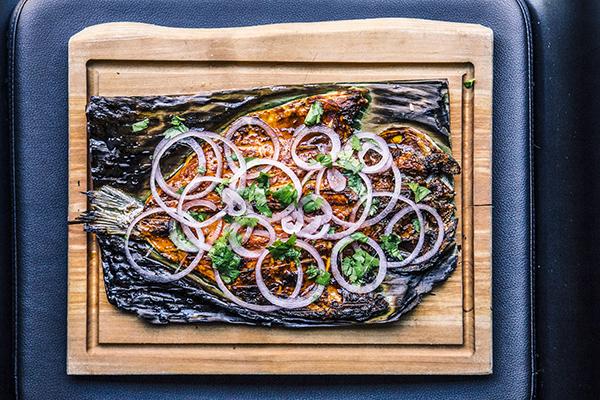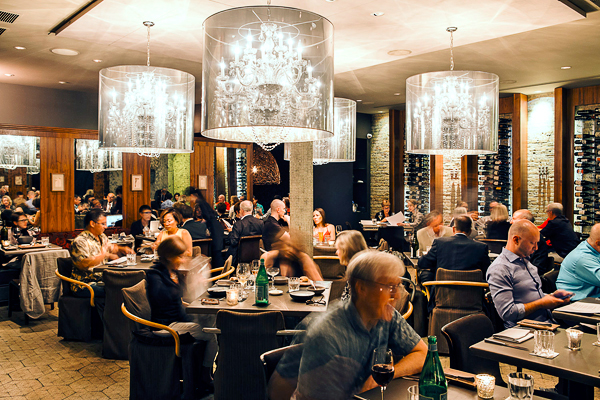
Sepia has been open for 10 years now and has held on to its Michelin star for the past six, and I’ve yet to meet anyone with an unkind word for the place. In fact, I rarely hear anyone mention Sepia at all.
Tucked away just off West Randolph Street, the sharp, idiosyncratic restaurant from executive chef Andrew Zimmerman and managing partner Emmanuel Nony has never fit into any category. With an emphasis on craftsmanship and a wine list heftier than Infinite Jest, Sepia strives to be more refined than most of the neighborhood’s more freewheeling establishments. And the general reaction seems to be, Sepia? Great restaurant. Gorgeous. Haven’t eaten there in ages.
In June, Zimmerman and Nony unveiled their follow-up, Proxi, around the corner. A bustling ode to international street food, Proxi has been a bash from day one. My knee-jerk reaction was that Zimmerman and Nony were desperate for a seat on the Randolph Street party wagon. But before screaming, Sellout! I decided to visit the two restaurants on back-to-back nights to see what this sibling relationship was all about.
In the shadows of the West Loop’s carnival, Sepia was mostly empty but still going about its business. The space, a former print shop built in the 1890s, is stunning. The art deco floor and Murano glass chandeliers give the dining room a provocative elegance. The same description applies to Zimmerman’s food, which doesn’t seem rooted to any time or place and roams more freely than you might imagine.
A gorgeous appetizer of tandoor-cured hamachi, accented with buttermilk, chayote, and cilantro, synthesizes multiple traditions to create something alternately rich and delicate. The grilled squid with long beans, chorizo verde, shaved cucumbers, and edible flowers sounds like an intercontinental train wreck, but the forceful mix of finely honed flavors (sweet, salty, tart) emerges earthy and new.

Sepia’s pasta game is strong. Saffron-kissed triangles serve as pillows for tiny pumpernickel croutons and thinly sliced green olives. Lift one up and you’ll find a hearty beef sugo—with an uppercut of flavor. And the corn-custard-filled masa agnolotti merge the rusticity of griddled tortillas with the East Asian punch of yuzu. The anything-goes ethos also gives Sepia the freedom to, say, stuff garlic sausage into rabbit loins, then wrap each meaty package in crisp bacon. It’s the kind of bold move that has mostly disappeared along with toqued French chefs.
My only misgivings center on Sarah Mispagel’s desserts, which try so hard to win your affection that they sometimes veer into Needyville. A “play on textures” is what the waitress called the hodgepodge of buttermilk panna cotta, white peach rooibos tea ice cream, ginger streusel, ginger gelée, molar-punishing honeycomb candies, and fresh blackberries. I call it a misguided mess. The envelope pushing works better in a deconstructed goat cheese cheesecake enhanced by beet sorbet.
Whether proffering a watermelon shooter amuse-bouche or grinning over the blueberry macarons and strawberry-marshmallow mignardises, the servers exude quiet confidence and charm, without the smug wink that many other restaurants seem to think we want.
Sepia knows exactly what it is, glittering without boasting, and doing so in a manner more playful than you may remember. It’s grown-up but also exhilarating. The two, it turns out, are not mutually exclusive.
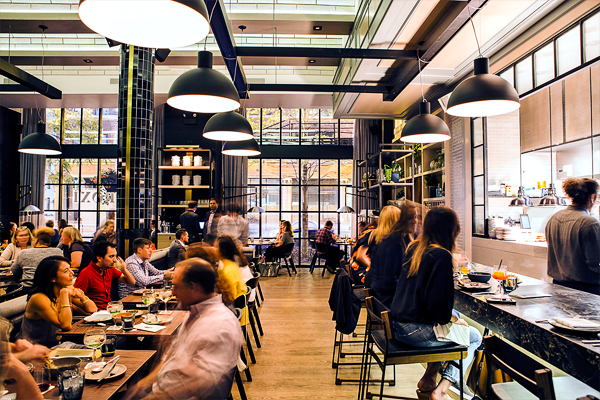
Half a block away at Proxi, the cacophony pummels you the second you open the door. The giddy atmosphere extends from the wood-planked floor all the way to the soaring barrel-vaulted ceiling. Meyer Davis, a celebrated New York–based design firm, reimagined the space, also a former print shop, as a kinetic urban hub wrought in marble, leather, and wood.
The menu contains an earnest mission statement filled with the kind of boilerplate restaurantese that sets my eyes rolling: “a fresh and innovative American lens,” “pristine ingredients,” “the bold flavors of multicultural street food.” But Zimmerman and Nony have enough goodwill banked with me that they could have reprinted the Instagram posts of multiple Kardashians between dish descriptions and I’d have been OK with it.
Proxi’s street food umbrella covers an insane amount of territory: Indonesian pork jerky here, tempura elotes there, Thai and Indian influences everywhere. While you’re dipping grill-scorched paratha into a thick roasted eggplant purée studded with pomegranate seeds, your tablemate may be slicing into raw tuna with coconut cream, lemongrass, and ginger sorbet. Forks will meet in the middle over a curled, glistening merguez sausage with eggplant aïoli.
Yet the globetrotting never feels scattershot, and that’s because Zimmerman’s flavor combinations are airtight. The kitchen’s command of disparate tastes allows it to upend dishes that look familiar, such as the Burrata plate, on which leek ash and blackened sourdough radiate a smoky current that cuts through a sweet sunchoke conserve and the fatty, whey-like cheese. The team also knows when to play it straight, goosing a hunk of cobia with a curry leaf and mooring it in a turmeric-tinged coconut sauce. The white-fleshed fish is a canvas on which the familiar flavors of Thailand have been painted.
I saw multiple diners going gaga over a colorful little salad. Turns out it was a special of pickled watermelon, mint, Thai chili rings, and crisp pork belly cubes that had been braised, breaded, and fried in a way that fully exploited the meat’s gorgeous layers. Loved it.
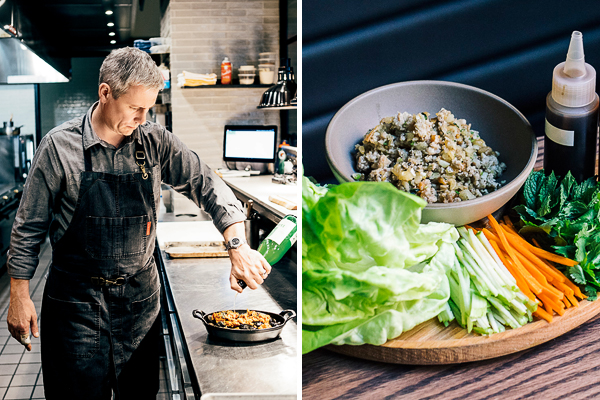
With a menu this broad, duds are bound to surface: the strangely muted wagyu beef short rib in Malaysian curry, for example, or the dried-out whole daurade served on a blackened banana leaf with pickled onions—easy targets, both missed by a mile. And, again, I didn’t connect with Mispagel’s cockeyed desserts, such as the murky green avocado mousse topped with a crisp pandan leaf, tapioca pearls, fresh grapefruit, and cocoa nibs—more conceit than coalescence. The saucy cocktails fared better, like the El-Otay, a margarita made with grilled-corn-infused tequila and agave-lime syrup, served in a glass rimmed with spicy Tajín seasoning.
I expected more from the frisky servers, who, after bringing out dishes in a herky-jerky rush, went into hiding until check time. The experience isn’t half as polished as the one at Sepia—but it isn’t meant to be. Despite the chaos, I find myself eager to return. The place has been billed as the restaurant where the Sepia folks finally let down their hair, but that isn’t entirely accurate, considering it’s always been down. Proxi, which seizes upon Zimmerman’s wanderlust in a way that feels organic, is good in its own right. Yes, Sepia is the more exceptional choice, but if Proxi steers the masses to this unconventional chef’s food, we all win.
